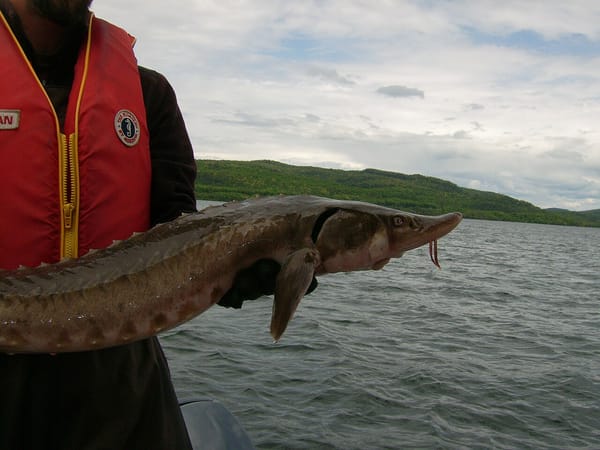For cabin owners across Canada, few sights are as thrilling as watching a Northern Pike explode through the water's surface in pursuit of prey. These magnificent predators are as much a part of the Canadian cottage experience as loons calling at dusk or the smell of cedar in the morning air.
Meet the Water Wolf

The Northern Pike (Esox lucius), often called the "water wolf" for its predatory nature, is one of North America's most formidable freshwater fish. "Jackfish", another name they're known for, have an elongated, torpedo-shaped bodies, distinctive olive-green coloring with light spots, and mouths full of razor-sharp teeth. Pike are perfectly designed killing machines that have patrolled our waters for millions of years.

These fish can grow to impressive sizes, with specimens reaching over 40 pounds and lengths exceeding 50 inches.
The official Canadian record stands at an astounding 42.12 pounds, caught in Saskatchewan in the 1950s, though you'll hear tales of even larger ones.
Most pike you'll encounter around your cabin will range from 2 to 10 pounds – still providing plenty of excitement for anglers and nature watchers alike.
Where Pike Call Home
Northern Pike are remarkably adaptable and can be found in lakes, rivers, and wetlands across Canada, from the Maritime provinces to British Columbia and throughout the territories. They thrive in the cool, weedy waters that characterize so many Canadian cottage lakes.

Pike prefer areas with abundant aquatic vegetation where they can ambush prey. Look for them along weed edges, near fallen trees, around rocky points, and in back bays. During hot summer months, larger pike often move to deeper, cooler waters, while smaller fish remain in the shallows. In spring, they migrate to marshy areas and flooded vegetation to spawn, making early season fishing particularly productive.

Ultimate Fishing Challenge
For many cabin owners, pike fishing is a cherished tradition. These aggressive predators provide heart-pounding action and are relatively easy to catch, making them perfect for introducing children and newcomers to fishing. However, landing a trophy pike requires skill, knowledge, and often a bit of luck.

Best Times to Fish
Pike are most active during cooler parts of the day – early morning and late evening during summer months. Spring and fall offer all-day action as water temperatures are more moderate. Many experienced anglers swear by overcast days, when pike feel more comfortable venturing from cover.
Effective Techniques and Tackle
Pike will attack almost anything that moves, but some methods consistently produce results:

Casting: Most popular method; large spoons, spinnerbaits, and crankbaits worked along weed edges are classic pike producers. The key is to use lures that create vibration and flash to trigger the pike's predatory instincts.
Trolling: Covering water with deep-diving crankbaits or large spoons can help locate active fish, especially in summer when pike spread out.
Live Bait: Where permitted, large minnows or suckers suspended under a float near structure can be deadly, particularly for trophy fish.
Fly Fishing: Increasingly popular, fly fishing for pike with large streamers provides an incredible experience for those seeking a challenge.
Always use a steel leader when pike fishing – their teeth will slice through regular fishing line instantly. A good landing net, long-nosed pliers, and jaw spreaders are essential for safely handling these toothy predators.
Ecological Role of Pike

Northern Pike play a crucial role in maintaining healthy lake ecosystems. As apex predators, they help control populations of smaller fish, preventing any one species from becoming too abundant. This natural balance is important for maintaining water quality and ensuring diverse fish populations.
Pike are opportunistic feeders, consuming whatever fits in their considerable mouths – from small fish and frogs to ducklings and muskrats. This varied diet makes them important in transferring energy through the food web. Their presence often indicates a healthy, balanced ecosystem, something every cabin owner should appreciate.
Living with Pike
Maintaining Fish Populations
If you enjoy fishing from your cabin, practice selective harvest. Keep smaller pike (2-5 pounds) for eating while releasing the larger breeding fish. This ensures a healthy population for future generations. Many lakes actually benefit from pike harvest, as they can become overpopulated with small, stunted fish without proper management.
Wildlife Watching
Pike provide excellent wildlife watching opportunities. Look for:
- "Pike rolls" – when they surface to gulp air
- Baitfish scattering in panic as pike hunt
- Weed beds moving as large pike cruise through
- Birds like herons and ospreys that also hunt pike

A Recipe for Success
Despite their reputation, pike make excellent table fare when prepared properly. The key is removing the Y-bones that run along the lateral line.
Beer-Battered Pike
Ingredients:
- 2 pounds pike fillets, deboned and cut into strips
- 1 cup flour
- 1 bottle of your favorite beer
- 1 tsp salt
- 1 tsp paprika
- 1 tsp onion powder
- 1 tsp garlic powder
- Oil for frying
Directions:
- Mix flour, salt, onion powder, garlic powder and paprika
- Slowly add beer until batter reaches pancake consistency
- Heat oil until it starts to sizzle
- Dip pike strips in batter and fry until golden brown
- Serve with lemon
The Pike Legacy

Northern Pike have been part of the Canadian wilderness for thousands of years, and with proper stewardship, they'll continue to thrill cabin owners for generations to come. If you're battling a monster on the end of your line, watching them hunt in the shallows, or simply knowing they're out there keeping your lake's ecosystem in balance, pike add an element of wildness to cottage life that connects us to something primal and authentic.
This summer, when you're at your cabin and see a swirl in the weeds or a splash near the lily pads, take a moment to appreciate these magnificent predators.
They're not just fish – they're an important part of what makes Canadian cabin living so special.






Join the Conversation